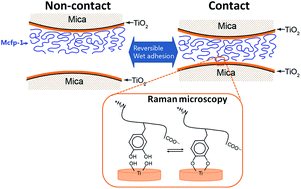Mussel foot protein-1 (mcfp-1) interaction with titania surfaces†
Abstract
Marine mussels utilize a variety of DOPA-rich

* Corresponding authors
a
POSTECH Ocean Science and Technology Institute, Pohang University of Science and Technology, Pohang 790784, South Korea
E-mail:
dshwang@postech.ac.kr
b Department of Biomaterials, Max Planck Institute for Colloids and Interfaces, 14424 Potsdam-Golm, Germany
c
Department of Chemical Engineering, University of Alberta, Canada
E-mail:
hongbo.zeng@ualberta.ca
d
Materials Research Laboratory, University of California, Santa Barbara, California 93106, USA
E-mail:
waite@lifesci.ucsb.edu
Marine mussels utilize a variety of DOPA-rich

 Please wait while we load your content...
Something went wrong. Try again?
Please wait while we load your content...
Something went wrong. Try again?
D. S. Hwang, M. J. Harrington, Q. Lu, A. Masic, H. Zeng and J. H. Waite, J. Mater. Chem., 2012, 22, 15530 DOI: 10.1039/C2JM32439C
To request permission to reproduce material from this article, please go to the Copyright Clearance Center request page.
If you are an author contributing to an RSC publication, you do not need to request permission provided correct acknowledgement is given.
If you are the author of this article, you do not need to request permission to reproduce figures and diagrams provided correct acknowledgement is given. If you want to reproduce the whole article in a third-party publication (excluding your thesis/dissertation for which permission is not required) please go to the Copyright Clearance Center request page.
Read more about how to correctly acknowledge RSC content.
 Fetching data from CrossRef.
Fetching data from CrossRef.
This may take some time to load.
Loading related content
